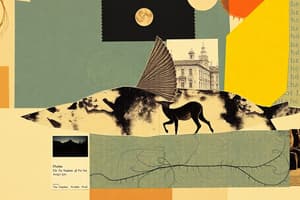Podcast
Questions and Answers
Why was modern classification invented?
Why was modern classification invented?
Scientists understood that species share a common ancestor.
Which best describes traditional classification?
Which best describes traditional classification?
It is based on shared characteristics.
What can a scientist discover by using molecular clocks when examining a new organism related to clownfish?
What can a scientist discover by using molecular clocks when examining a new organism related to clownfish?
The amount of time that the two species have been evolving apart.
Which describes the modern classification system?
Which describes the modern classification system?
In a cladogram, what occurs at a node?
In a cladogram, what occurs at a node?
What are phylogenetic trees also called?
What are phylogenetic trees also called?
According to the cladogram, which organisms have roundworms as a common ancestor?
According to the cladogram, which organisms have roundworms as a common ancestor?
Which best describes derived characteristics?
Which best describes derived characteristics?
What is the implication of a changing hypothesis regarding protist classification?
What is the implication of a changing hypothesis regarding protist classification?
To which modern animal is Dr. Digger's creature most closely related based on anatomical similarities?
To which modern animal is Dr. Digger's creature most closely related based on anatomical similarities?
Flashcards are hidden until you start studying
Study Notes
Modern and Traditional Classification
- Modern classification was developed to reflect the understanding that species share a common ancestor.
- Traditional classification relies on shared characteristics among organisms for grouping.
Molecular Clocks and Evolution
- Molecular clocks help scientists estimate the amount of time two related species, such as a new organism and clownfish, have been evolving apart.
Cladograms and Phylogenetic Trees
- The modern classification system is founded on evolutionary relationships.
- Cladograms and phylogenetic trees represent these relationships visually.
- A node in a cladogram signifies the appearance of a derived trait.
Characteristics and Definitions
- Derived characteristics are newly evolved traits that differentiate groups of organisms.
- Protists are eukaryotic organisms that are neither plants, animals, nor fungi and are characterized by their diversity; their classification remains uncertain and subject to change as new data emerges.
Ancestors and Relationships
- According to a certain cladogram, mollusks, echinoderms, chordates, and annelids share a common ancestor with roundworms.
- Dr. Digger's fossil discovery refers to a creature with a fused backbone and flippers, suggesting a close relation to modern sea turtles based on anatomical similarities.
Studying That Suits You
Use AI to generate personalized quizzes and flashcards to suit your learning preferences.




